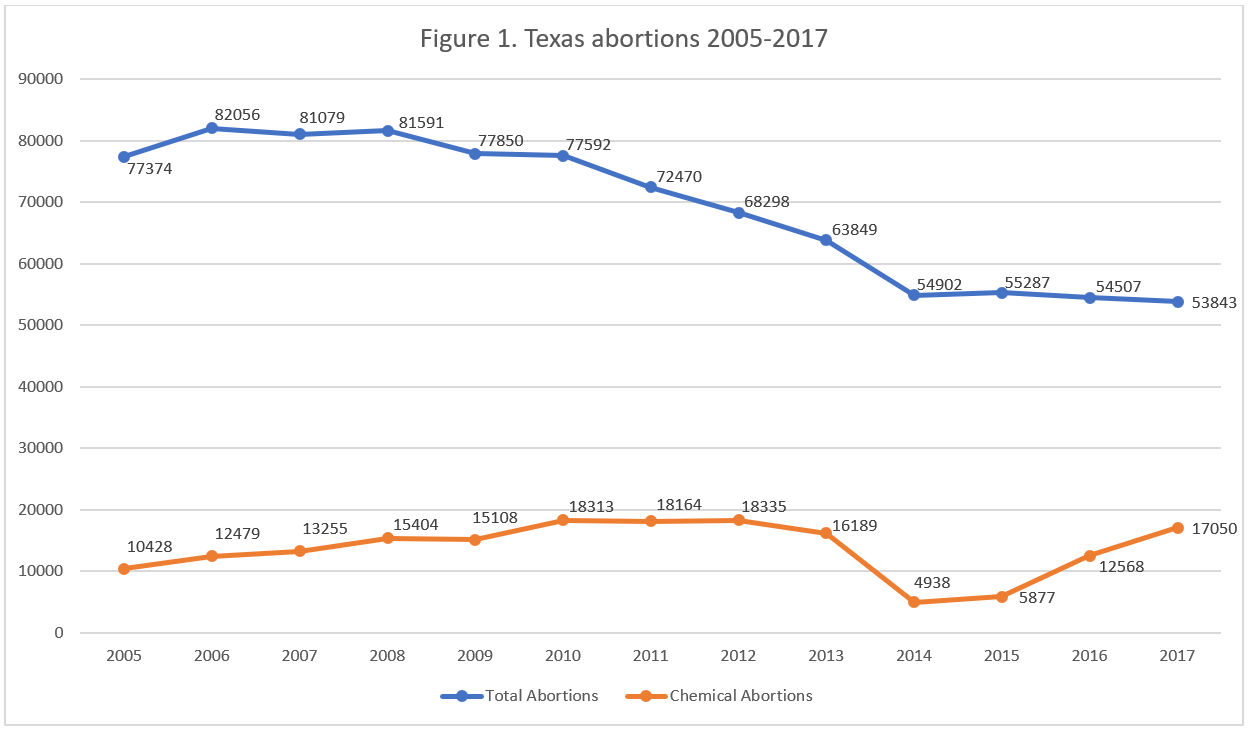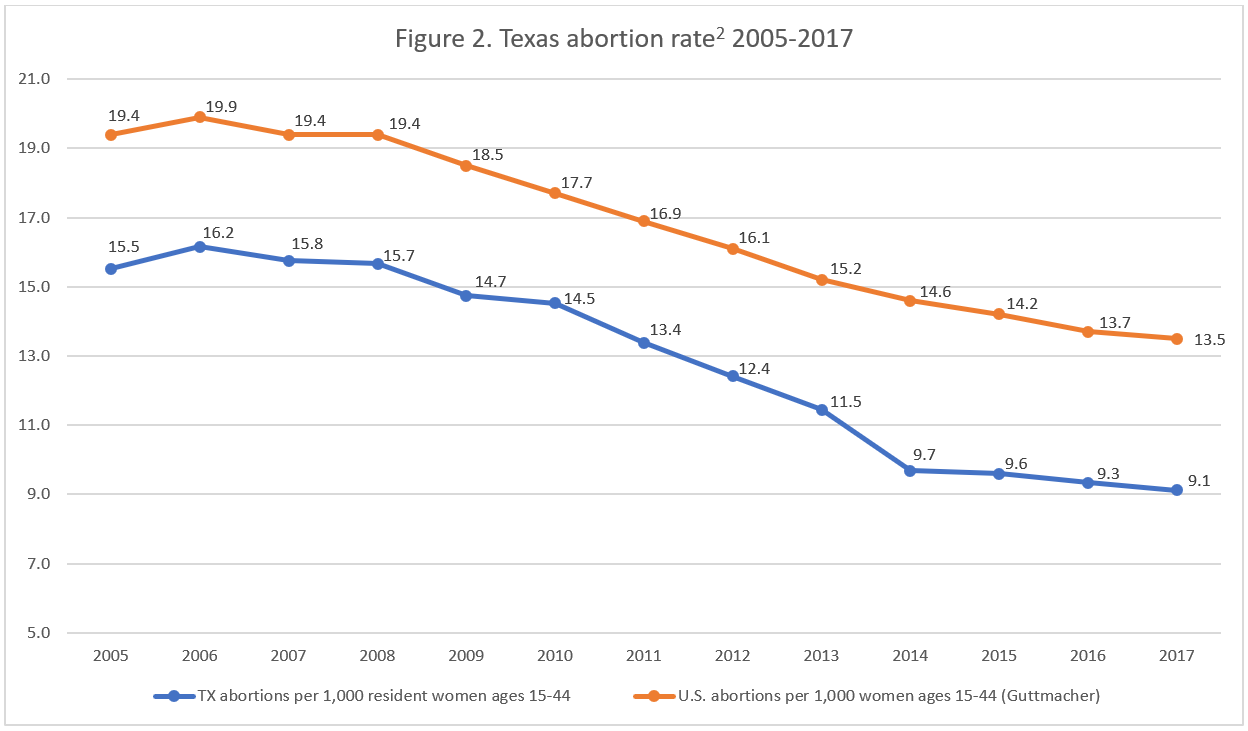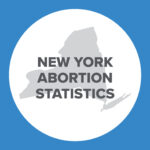Abortion Reporting: Texas (2017)

Texas’ annual abortion report for 2017 was published on the website of the Texas Department of Health and Human Services in August 2019. The report shows that abortions in the Lone Star State continue to fall.
Changes in Texas Abortions, 2016-2017

Information on Texas’ state abortion rate and Planned Parenthood’s Texas market share is not publicly available.
Abortion Totals and Trends
Total Texas abortions decreased by one percent from 54,507 in 2016 to 53,843 in 2017. At the same time, chemical abortions increased to 12,568, an increase of 36 percent, or nearly 4,500 more, from just the previous year (Fig. 1). In 2014, chemical abortions in Texas dropped sharply, but have been trending upward since then. Chemical abortions made up 32 percent of all reported Texas abortions in 2017. The Charlotte Lozier Institute estimates that Texas’ 2017 abortion rate was 9.1 abortions per 1,000 women of childbearing age (Fig. 2).
State Report Summary
There were 53,277 abortions reported in Texas in 2017, of which 52,269 were performed on Texas residents (98 percent) and 1,174 were performed on nonresidents (two percent). An additional 566 abortions were performed on Texas residents in other states for a total of 53,843 Texas abortions.
Fifty-one percent of Texas abortions were performed in ambulatory surgical centers. Forty-eight percent were performed in centers that were licensed as abortion facilities, and one percent were performed on Texas residents in other states. Eighty-nine abortions were performed in hospitals (0.2 percent), and 41 were performed in physicians’ offices (0.1 percent).
Eighty-three percent of Texas abortions were performed before nine weeks post-fertilization. Seven percent were performed between nine and 10 weeks, and four percent were between 11 and 12 weeks. Three percent occurred between 13 and 14 weeks post-fertilization. One-and-a-half percent were performed between 15 and 16 weeks, and another 1.5 percent occurred between 17 and 20 weeks post-fertilization. There were 15 Texas abortions between 21 and 24 weeks post-fertilization, of which three were performed out of state, and one abortion at 25 weeks post-fertilization or later that was performed in Texas. In 60 cases, post-fertilization age was not stated.
Sixty-two percent of Texas abortions were performed via suction curettage. Thirty-two percent were chemical abortions, and six percent were performed using dilation and evacuation. There were two intrauterine instillation abortions, six sharp curettage abortions, and four hysterectomy/hysterotomy abortions. Eighty-two abortions were performed using unreported methods. Of the suction curettage abortions, 439 were performed on Texas residents out-of-state. Thirty-five of the chemical abortions, 14 of the dilation and evacuation abortions, and 78 of the abortions with unreported methods were performed on Texas residents in other states.
Of all Texas abortions, nine percent were on girls age 19 or younger (including 0.2 percent on girls under the age of 15). Fifty-eight percent were performed on women in their twenties, with 30 percent on women ages 20 to 24 and 28 percent on women ages 25 to 29. Twenty-nine percent of the abortions were on women in their thirties and four percent on women ages 40 or older. Thirty-eight percent of Texas abortions were performed on Hispanic women. Twenty-seven percent each were performed on non-Hispanic white and black women, and six percent were on non-Hispanic Asian women. Just 0.4 percent were on non-Hispanic Native American women and one percent on women of a different race.
Some of the information in Texas’ abortion report is available for Texas residents only. Eighty-two percent of the abortions performed on Texas residents in 2017 were on unmarried women, while 18 percent were on women who were married. Thirty-nine percent of the resident women had no previous live births, while 24 percent had one previous live birth and 37 percent had more than one. Sixty-two percent had no prior abortions. A quarter had undergone one abortion previously, and 13 percent had two or more previous abortions.
Twenty-two of the abortions performed in Texas on Texas residents were reported to have resulted in complications.1 Eleven resulted in hemorrhages, five led to shock, and one caused a uterine perforation. There were five additional, unspecified complications. It was unknown whether the 566 abortions obtained by Texas residents in other states caused complications. The month of March had the highest number of resident abortions (5,311), and the month of August had the lowest (3,928).
Texas After Hellerstedt
2017 marked the first full year after the U.S. Supreme Court issued a decision in Whole Woman’s Health v. Hellerstedt. The Supreme Court ruling overturned laws that Texas had implemented in 2013 to hold abortion facilities and doctors to certain safety standards. Opponents of the laws argued that the laws overly restricted abortion access in Texas; in fact, after the laws went into effect, 27 out of 42 Texas abortion clinics shut down due to inability to meet the standards. Texas abortions plummeted after 2013, and an increasing number of Texas women sought abortions in other states.
Despite the removal of the safety standards, Texas abortions continued to drop in 2017, and abortion facilities have been slow to reopen. However, the number of Texas women traveling out of state for abortions declined by 58 percent from 1,347 in 2015 to 566 in 2017, with no corresponding increase in Texas women obtaining abortions in Texas. In-state resident abortions actually decreased by two percent over the two-year period. There are more abortion facilities operating in Texas in 2017 than there were in 2015, yet total abortions occurring in the state dropped by one percent between 2015 and 2017. These trends suggest that Texas abortion totals are affected by multiple factors, rather than just the laws blocked by the Hellerstedt decision. Previously enacted regulations may also have impacted the Texas abortion rate over the years, such as Texas’ 2011 modification to its family planning system to cut funding from abortion providers.
State Ranking
In the Charlotte Lozier Institute’s 2016 survey of state abortion reporting, Texas’ reports were ranked at 15th best. Texas has increased the speed with which data is made publicly available, releasing its 2017 annual abortion report just a few months after the 2016 report was published. Texas could further improve its reporting by fully reporting on all abortions performed in Texas, rather than by restricting some tables to resident abortions only. Texas could also identify the states that Texans visit to obtain abortions and the states that women travel from to get abortions in Texas.


- Statistics on abortion complications reported here represent a minimal number of deaths and complications, as this data is collected in a non-systematic and non-verifiable way. As such, this data cannot be used to calculate either an accurate abortion mortality rate or an accurate abortion complication rate for the state.
- Texas does not report the state abortion rate. Rates were calculated by the Charlotte Lozier Institute using population estimates from the United States Census Bureau. The rates were calculated using the following formula: (abortions occurring in Texas and on Texas residents out of state ÷ number of resident women ages 15-44) x 1,000. Rates differ slightly from previous CLI articles due to revised population estimates. In 2018, Texas transferred its abortion reporting system from the Department of State Health Services to Texas Health and Human Services.


























